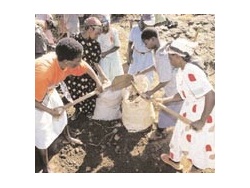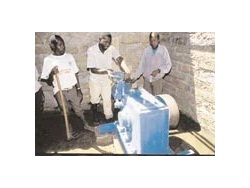 Eventually, they will get an Internet connection for virtually unlimited scope of possibilities.
Eventually, they will get an Internet connection for virtually unlimited scope of possibilities.
Ignoring the scorching midday heat, hundreds of villagers—husbands, wives and teenagers—struggle to control the waters of the local Tungu River in preparation for the micro hydro development. In the distance, mighty Mount Kenya rises to 5,199 kilometres with its famous snowcapped top. At the site, men, in groups of five, move heavy stones to make the water follow a small, 250-metres-long canal to the Kabiri Falls and a newly-installed turbine, while the women reinforce the walls along the river.
Using available natural resources, the villagers will soon be producing their own energy and piped water. Schools will light up, batteries will be charged, grinding mills will operate, and there will even be a small factory. With funding from the Global Environment Facility/Small Grants Programme, these new facilities will soon become a reality.
The Global Environment Facility (GEF) is a tripartite partnership of the United Nations Development Programme (UNDP), the World Bank and the United Nations Environment Programme.
Projects and programmes that receive GEF cofinancing are developed and implemented in collaboration with one of these three institutions.
 "We are very proud and happy to be able do this job ourselves. We don't want anyone else, be it a businessman or a politician, to make this a project of his own," says the chairman of the Village Committee, Fredrick Naku, addressing a crowd of exhausted villagers under a huge fig tree by the river.
"We are very proud and happy to be able do this job ourselves. We don't want anyone else, be it a businessman or a politician, to make this a project of his own," says the chairman of the Village Committee, Fredrick Naku, addressing a crowd of exhausted villagers under a huge fig tree by the river.
The villagers murmur their consent in the local Kimeru language. They are part of a newly formed community cooperative that will own and share the benefits of this micro hydro project. The 150 villagers have taken personal responsibility for the project, having been involved in it from the beginning. They are active shareholders, but no one holds more than 100 shares.
Revenues will be distributed evenly once a year.
With his arms full of construction maps, Stephen Gitonga of the Kenya branch of the Intermediate Technology Development Group (ITDG), consults with some of the village elders on how to proceed. This nongovernmental organization, affiliated to ITDG of the United Kingdom, builds on its experiences in similar projects in countries like Nepal, Peru and Sri Lanka. In Kaanwa, the work is carried out in close collaboration with the local community and the Ministry of Energy.
"We scanned most of Kenya for a suitable site, checking 24 possible locations in six months," recalls Gitonga, stressing that the project site would have to fulfil certain criteria. It would have to be a remote community, far from electric power supplies, yet easy to develop.
The choice fell upon Kaanwa, where most of its inhabitants struggle to survive by subsistence farming on plots as small as 0.1 acres. The villagers grow maize, beans and tobacco, and rear some cows and goats.
Catalytic effect
The hydro power project will definitely change the future, according to Nancy Josphia Kabiro and Dionision Njeru, two members of the cooperative. Both believe the energy project will help them survive in this drought prone region. Apart from helping Kabiro establish a long desired tailoring business and Njeru a welding service, electricity will open up many other possibilities.
 It will now be possible to store heatsensitive medical supplies in refrigerators in a region suffering from poor health services. There are also plans for an education centre, which will give villagers access to video material on anything, from agricultural extension to HIV/AIDS prevention.
It will now be possible to store heatsensitive medical supplies in refrigerators in a region suffering from poor health services. There are also plans for an education centre, which will give villagers access to video material on anything, from agricultural extension to HIV/AIDS prevention.
And this is just the beginning. The IT-age is just around the corner, with cyber cafés flourishing in Nairobi and other Kenyan cities, making the Internet available to everyone. Cell phones are also growing in popularity, with telecom companies displaying colourful ads along the highways. Soon most of the country will be covered.
But from the point of view of the central highlands of Kenya, all this is exclusively for the well-serviced communities along the main road between Nairobi and Meru. Beyond the bumpy, 12-kilometre dirt road connecting Kaanwa to Chuka, radios and some black-and-white TV sets are the only means of information. During the rainy season, even the most sophisticated fourwheel drive cannot make it to the village. This means isolation for weeks and even months.
A profound difference
But electricity will make a profound difference. With power to run computers, even remote villages like Kaanwa will be connected to the Internet, using the mobile net. "This development is of course far away. But once a community gets the means to 'plug in' to the IT world, it all happens very fast," says Gitonga.
The hydro power project in Kaanwa village is one of 15 similar efforts receiving funds from the Small Grants Programme.
An amount of US$38,000 has been provided for generation of the power and a further $25,000 for distribution, including pumping water to the micro-enter-prises to be developed.
The hard work of Kabiro, Njeru and the rest of the villagers to build the power plant has helped cut labour costs by some $7,000. The total value of the villagers' efforts is estimated at $20,000. When ready for use, the environment-friendly micro power project will generate 18 kilowatts. The Small Grants Programme will support 18 new projects this year, 12 of them in the Mount Kenya area. They all follow the GEF criteria of promoting biodiversity conservation, and mitigation of global warming. This year, some $680,000 have been allocated for the Small Grants Programme in Kenya.
Says Esther Mwangi, programme coordinator of UNDP/GEF projects in Kenya:
"This pilot project has had a catalytic effect, influencing the policy dialogue for electricity generation and distribution. The dynamic of the project has also been understood by the European Union, which is committing a large amount of co-financing to develop similar plants in other areas of the country through ITDG and Nottingham Trent University." A number of environmental benefits are also at hand. "The forest will recover since there will be no tree cutting for curing tobacco," says Chris G. Gakahu, a UNDP programme specialist. "Soil erosion and emission of greenhouse gases will also be reduced."
Says UNDP Deputy Resident Representative Tarirai Isaac Chivore: "There's no doubt that this pilot project will trigger a lot of development. It also fits in very well with the new vision of UNDP, touching on governance, partnership and trust building."




